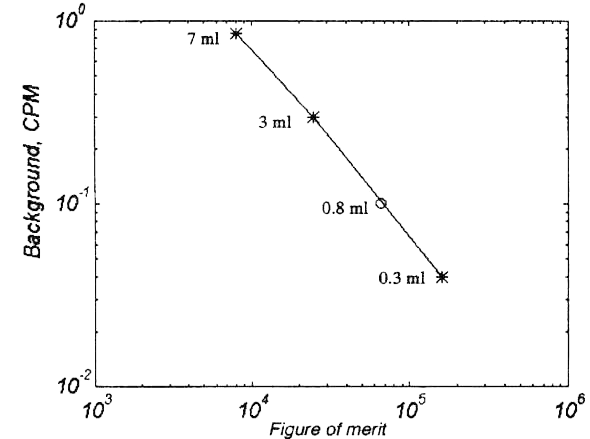
Small Sample Radiocarbon Dating
Background
Huge number of C-14 dating samples, which are either relatively small
or their material contains a low concentration of carbon dated with limited sample mass,
which can be taken into operation.
In both cases, the use of conventional radiocarbon dating for these samples result in small portions of benzene.
Issues
So we need to prepare
the sample with benzene as high as possible coefficient of chemical yield,
and then make the measurement of radiocarbon concentration in thw benzene sample
with a possible minimum diluting the sample material.
Decisions
Application of modern benzene line
allows you to work with samples, for which it is possible to
synthesize 100-200 mg of benzene at high chemical yield, and on request this module for micro samples could be included into set of equipment.
Application of hydrolysis module (See p. 4.2 of specification )
which allows you to apply the capsule technology to produce lithium carbide.
Capsule technology
is progressive by means of preparing a few samples in the same process
and what more it allows operating carbide samples some time later as each sample
is hermetic and could be stored.
Application of anti-radon module
decrease time of sample stabilization before
counting which is most important for small samples of benzene.
Recent progress in development and application of Super Performances Teflon vials for Conventional Radiocarbon Dating.
As it was stated ( Robert M Kalin and Austin Long, 1989 ) traditional Teflon vials may have limitation, like they are time consuming in operation and may require individual calibration in series and they have benzene leakage limitation.
Special Glass vials ( A.G. HOGG, 1992 ) will cover wide range of benzene volume measured (0.3 Ml to 10 Ml), when 10 Ml vials are most applicable for precise measurement of radiocarbon and when 0.3 Ml vials are suitable to provide accurate results with adequate precision for many applications, for samples containing 120-240 mg of carbon.
In addition it was shown that application of underground laboratory ( Wolfango Plastino and Lauri Kaihola, 2006 ) can significantly decrease counting background.
Recent developments ( Michael Buzinny and Vadim Skripkin, 1995 ) allow us to create of two parts 0.8 Ml Teflon vial with different holder which have quite good performances described above. Now we offer most recently developed ( Skripkin, unpublished) super performance (see photo above) Teflon vials which had got long durability, simple in use with different volumes: 0.8 ml, 1.5 ml, 2.5 ml, 4.0 ml 7.0 ml and have extreme Low benzene leakage.
Performances of Teflon vials, FOM vs Background
Producing benzene (small sample).
Capsule technology produces carbide high productively. It allow obtaining small benzene sample. It is well aplicable for both organic and carbonate samples. It is cheep and high effective. It allows simplification of all scheme obtaining of benzene because of highly pure carbide.
is a simple and highly productive for any kind of sample material.
Robert M Kalin and Austin Long. Radiocarbon Dating With The Quantulus In An Underground Counting Laboratory: Performance And Background Sources. RADIOCARBON, VOL 31, No. 3, 1989, PP 359-367.
A.G. HOGG. Performance And Design Of 03-Ml To 10-Ml Synthetic Silica Liquid Scintillation Vials For Low-Level 14C Determination. Liquid Scintillation Spectrometry 1992, edited by J.E.Noakes, F. Schonhofer and H. A. Polach. RADIOCARBON 1993, pp. 135-142.
Wolfango Plastino and Lauri Kaihola . Liquid Scintillation Counting At Gran Sasso National Laboratory: radiocarbon measurements. LSC 2005, Advances in Liquid Scintillation Spectrometry. Edited by Stanislaw Chalupnik, Franz Schonhofer,John Noakes. pp 435-438.
Michael Buzinny and Vadim Skripkin. Newly Designed 0.8-ML Teflon Vial For Micro-Volume Radiocarbon Dating.RADIOCARBON. Vol 37, No 2 (1995) PP. 743-747
Vadim Skripkin, Mykhailo Buzynnyi. Teflon Vials for Precise C-14 In Benzene Measurements by LSC Technique. LSC-2017 - an International Conference on advance in Liquid Scintillation Spectrometry, 1-5 May, Copenhagen, Denmark. Book of abstract. p.72.
Vadim V Skripkin, Nikolai N Kovaliukh. Production Of Lithium Carbide From Very Small Organic And Carbonate Samples For Liquid Scintillation Radiocarbon Analysis. ZESZYTY NAUKOWE POLITECHNIKI SLASKIEJ - 1996. Seria: MATEMATYK A-FIZYKA z. 79. GEOCHRONOMETRIA 13. Nr kol. 1330
Youtube channel: benzene-line.com
